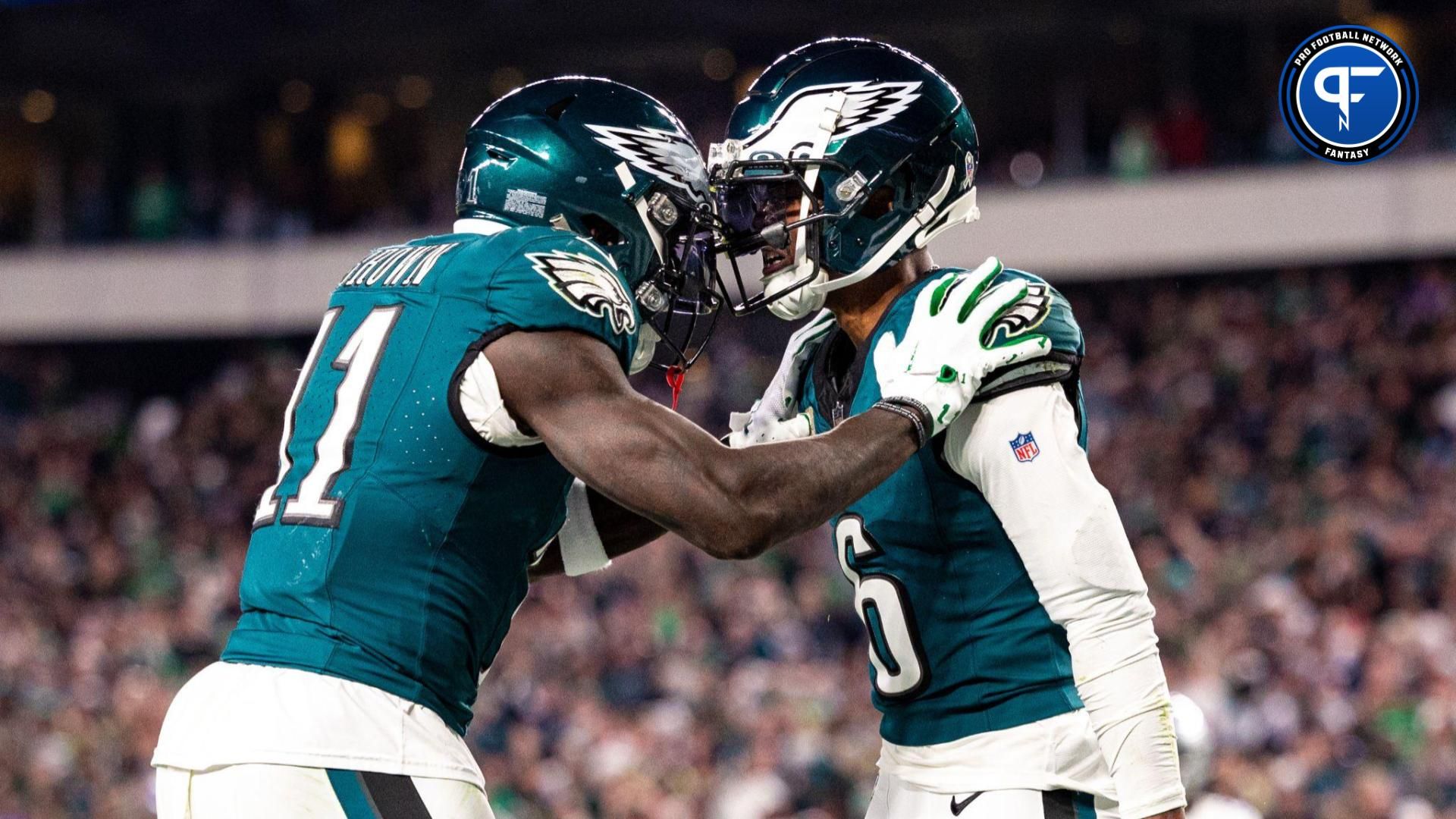In our fantasy football drafts, our goal is always the same — draft the players who we think will score the most points. In preparing for our drafts, we look for edges, trends, or any insight we can find that will help direct us to those players. What if I told you something as simple as whether a wide receiver is his NFL team’s WR1 could be quite informative on how that player will perform in fantasy?
Should Fantasy Football Managers Always Prioritize NFL WR1s Over NFL WR2s?
Intuitively, this likely isn’t much of a surprise. The best wide receivers in football are going to be their NFL teams’ WR1s. You don’t need any advanced analysis to tell you to draft CeeDee Lamb, Ja’Marr Chase, or Tyreek Hill.
The first round of fantasy drafts isn’t overly difficult. Most of the second round can be straightforward as well. Where this analysis helps is when you get toward the 2/3 turn and into the middle rounds, when the wide receivers all have concerns and varying degrees of upside.
The Study
Volume is king in fantasy football. We want wide receivers who are going to see a lot of targets. Who gets the most targets? The WR1s.
This got me thinking about how we should value objectively talented players who were not their NFL team’s WR1 back in 2021. I decided to look back at the fantasy points per game finishes of the top 36 WRs. Five years felt like a large enough sample size while not going too far back to a point where the NFL was too different than it is now.
Given that I initially did this in 2021, I went back through 2017. I have since updated the study to include 2022 and 2023, so we now have seven years of data. Allow me to walk you through my process.
The dataset is as simple as it gets: fantasy points per game. Since the WR1/2/3 thresholds change every year based on how players perform, I used the following parameters:
WR1: 16+ points per game
WR2: 14-16 points per game
WR3: 13-14 points per game
My goal was to figure out how many wide receivers in each bucket were their NFL team’s WR1.
Now, there is admittedly some level of subjectivity to this. With guys like the aforementioned Lamb, Hill, and Chase, there is no debate — they are their NFL teams’ WR1s. For other teams, it may not be as clear. For brevity’s sake, I am not going to list how I designated all 36+ WRs for each of the past seven seasons. You’ll just have to trust me!
16+ ppg (WR1)
2023: 13 WRs in this range, 12 of them were their team’s WR1
2022: 11 WRs in this range, 11 of them were their team’s WR1
2021: 11 WRs in this range, 10 of them were their team’s WR1
2020: 14 WRs in this range, 11 of them were their team’s WR1
2019: 8 WRs in this range, 7 of them were their team’s WR1
2018: 19 WRs in this range, 14 of them were their team’s WR1
2017: 7 WRs in this range, 7 of them were their team’s WR1
Total (last seven seasons): 72/83 = 86.7%
14-16 ppg (WR2)
2023: 9 WRs in this range, 5 of them were their team’s WR1
2022: 6 WRs in this range, 3 of them were their team’s WR1
2021: 15 WRs in this range, 6 of them were their team’s WR1
2020: 15 WRs in this range, 8 of them were their team’s WR1
2019: 19 WRs in this range, 9 of them were their team’s WR1
2018: 4 WRs in this range, 2 of them were their team’s WR1
2017: 8 WRs in this range, 5 of them were their team’s WR1
Total (last seven seasons): 38/76 = 50.0%
13-14 ppg (WR3)
2023: 8 WRs in this range, 3 of them were their team’s WR1
2022: 10 WRs in this range, 5 of them were their team’s WR1
2021: 3 WRs in this range, 2 of them were their team’s WR1
2020: 7 WRs in this range, 0 of them were their team’s WR1
2019: 3 WRs in this range, 2 of them were their team’s WR1
2018: 4 WRs in this range, 1 of them was their team’s WR1
2017: 6 WRs in this range, 5 of them were their team’s WR1
Total (last seven seasons): 18/41 = 43.9%
Here are the final numbers all in one spot.
16+ ppg: 85.7% were their team’s WR1
14+ ppg: 49.2% were their team’s WR1
13+ ppg: 44.1% were their team’s WR1
How Can We Apply This Information in 2024 Fantasy Drafts?
On a very basic level, the answer is simple: We should prioritize drafting NFL WR1s over NFL WR2s. Of course, there’s more nuance than that, though.
If you want 16+ fantasy points per game, it’s abundantly clear the best shot at that is to take a wide receiver who is the No. 1 for his NFL team. However, as our fantasy drafts progress, what we’re looking for in the players we select needs to change.
There comes a point in every draft where plausible WR1 upside no longer exists. If you want to chase WR1 upside, then sure, go ahead and select Terry McLaurin over Jaylen Waddle. You would never do that, though. And I’d never tell you to do that.
MORE: 6 Potential Fantasy Football Breakouts to Target in 2024
McLaurin and Waddle are perfect players to use to illustrate how this data can be misapplied. They are two WRs with no ambiguity as to their status with their NFL team. There is absolutely no debate that McLaurin is the Washington Commanders’ WR1 and Waddle is the Miami Dolphins’ WR2.
The historical data unequivocally suggests McLaurin is more likely to average 16+ points per game than Waddle. Yet, Waddle is going several rounds ahead of McLaurin, and rightfully so.
Waddle falls into the fantasy WR2 bucket. Given that only 50% of fantasy WR2s are their NFL teams’ WR1s, there’s no statistical advantage in blindly going with an NFL WR1 over an NFL WR2. We believe Waddle to be the more talented player on the better offense. Waddle has outscored McLaurin every year of his career. Therefore, Waddle is rightfully selected ahead of him.
This information is most useful when it’s close. Currently, the top 13 WRs by ADP are all NFL WR1s. The first one who is not is Deebo Samuel.
We have a decent number of NFL WR2s in the WR13-24 range. Stefon Diggs is one spot above Mike Evans. Waddle is two spots above Michael Pittman Jr. DeVonta Smith is sandwiched between DK Metcalf and Zay Flowers.
It goes without saying your personal rankings and evaluations should play a factor here. If you don’t think these players are as close as ADP suggests, then don’t allow this study to overrule all other analyses. Never do that with any one data point.
In terms of finishing as fantasy WR2s (14-16 points per game), history suggests the players listed all have similar chances to do so. But, as we know, upside wins championships.
We’re talking about second-, third-, and fourth-round picks. Wide receivers selected in these rounds of fantasy drafts are capable of reaching 16+ points per game. When possible and reasonable, we should chase that.
Therefore, if you’re struggling to decide between two players you have valued very closely, use this study as a tiebreaker. Go with Evans over Diggs. Go with Pittman over Waddle.
The past three seasons have each seen just one NFL WR2 average at least 16 fantasy points per game. If you believe the players you’re deciding between have that upside, perhaps consider leaning more toward the one who is his NFL team’s WR1.

